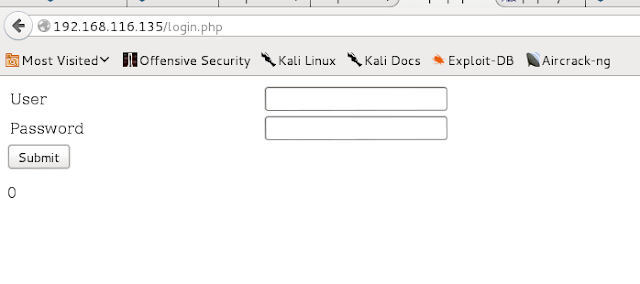Walkthrough Droopy v.02 :
In this post i shall outline the steps i followed to get root on Droopy hosted at vulnhub . https://www.vulnhub.com/entry/droopy-v02,143/.
From this post onwards i shall try to enlist all the useful links i used to compromise the box for posterity.
Detailed Steps to root :
A nmap scan of the box reveals that only port 80 is open and there seems to be a Drupal 7 website hosted. After running nikto and dirbuster i decided to run a tool to enumerate CMS's. I know a good one exists for wordpress but surpisingly i could not find much for Drupal. I did come across a tool called CMSMap which according to this github page enumerates wordpress, drupal and joomla . I decided to give this a try to see any information it could reveal. Also i really wanted to be able to learn about Drupal enumeration tools and techniques.
Since the tool is not already built in Kali i decided to follow the github instructions and build it on my box.
The tool was quite good at enumerating the Drupal website and immediately tells us that the site is outdated and suffers from a known vulnerability "Drupal Vulnerable to SA-CORE-2014-005".
Seems like there exists a possibility of launching SQL injection attacks against the box. I decided to use an existing exploit against the box. The exploit https://www.exploit-db.com/exploits/34984/ helps to change the admin credentials on the backend site.
The exploit worked and now we have changed the admin credentials on the box. We now login to the box with credentials "admin:hello".
Once we are able to login to the box we are able to create additional posts/pages. Checking under the "Modules" tab i see that there is a plugin called "phpfilter" which can be enabled to allow php content to be executed on the webpage. This opens the possibility of executing some php reverse shell code by creating a webpage and executing the same via the webserver. Hence we try this approach. I use standard reverse shell from pentest monkey.
Once we get a reverse shell we see that the box is a 64bit ubuntu 14.04 box which is known to be vulnerable to local priv escaltion exploit https://www.exploit-db.com/exploits/37292/ We compile and run the exploit to get root on the box .
Also for completeness I must admit I could have also used a Metasploit module to get a shell but i wanted to avoid using metasploit as much as possible :0
Final Verdict :
Overall it was relatively easy box to pawn but fun nevertheless. Thanks for the creator to take time to create one . Keep up the good work "knightmare" .
Useful Links :
https://github.com/Dionach/CMSmap
https://www.drupal.org/SA-CORE-2014-005
https://www.exploit-db.com/exploits/37292/
https://www.rapid7.com/db/modules/exploit/multi/http/drupal_drupageddon
In this post i shall outline the steps i followed to get root on Droopy hosted at vulnhub . https://www.vulnhub.com/entry/droopy-v02,143/.
From this post onwards i shall try to enlist all the useful links i used to compromise the box for posterity.
Detailed Steps to root :
A nmap scan of the box reveals that only port 80 is open and there seems to be a Drupal 7 website hosted. After running nikto and dirbuster i decided to run a tool to enumerate CMS's. I know a good one exists for wordpress but surpisingly i could not find much for Drupal. I did come across a tool called CMSMap which according to this github page enumerates wordpress, drupal and joomla . I decided to give this a try to see any information it could reveal. Also i really wanted to be able to learn about Drupal enumeration tools and techniques.
Since the tool is not already built in Kali i decided to follow the github instructions and build it on my box.
The tool was quite good at enumerating the Drupal website and immediately tells us that the site is outdated and suffers from a known vulnerability "Drupal Vulnerable to SA-CORE-2014-005".
Seems like there exists a possibility of launching SQL injection attacks against the box. I decided to use an existing exploit against the box. The exploit https://www.exploit-db.com/exploits/34984/ helps to change the admin credentials on the backend site.
The exploit worked and now we have changed the admin credentials on the box. We now login to the box with credentials "admin:hello".
Once we are able to login to the box we are able to create additional posts/pages. Checking under the "Modules" tab i see that there is a plugin called "phpfilter" which can be enabled to allow php content to be executed on the webpage. This opens the possibility of executing some php reverse shell code by creating a webpage and executing the same via the webserver. Hence we try this approach. I use standard reverse shell from pentest monkey.
Once we get a reverse shell we see that the box is a 64bit ubuntu 14.04 box which is known to be vulnerable to local priv escaltion exploit https://www.exploit-db.com/exploits/37292/ We compile and run the exploit to get root on the box .
Also for completeness I must admit I could have also used a Metasploit module to get a shell but i wanted to avoid using metasploit as much as possible :0
Final Verdict :
Overall it was relatively easy box to pawn but fun nevertheless. Thanks for the creator to take time to create one . Keep up the good work "knightmare" .
Useful Links :
https://github.com/Dionach/CMSmap
https://www.drupal.org/SA-CORE-2014-005
https://www.exploit-db.com/exploits/37292/
https://www.rapid7.com/db/modules/exploit/multi/http/drupal_drupageddon


























